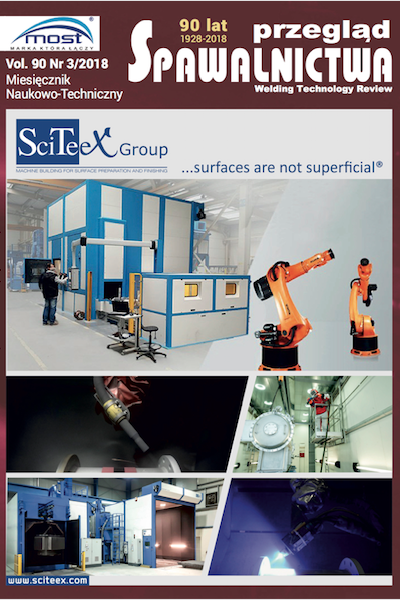High-performance Electrical Discharge Machining of small hole in metallic ceramic composites
Main Article Content
Abstract
The paper presents the result of the influence of the work- ing electrode material on high performance Electrical Discharge Machining. In the studies been taken into account two input factors: impulse time ton and pressure change of the dielectric p, at the fixed others parameters of Electrical Discharge Machining. Composite material SiC-Ni with 20% silicon carbide, single-channel and multi-channel tubular electrodes made of brass and copper were machined. Getting the numerical results of parameters characterizing the machined surface, which allowed us to formulate proposals for the machining of these materials.
Downloads
Article Details
Creative Commons CC BY 4.0 https://creativecommons.org/licenses/by/4.0/
Welding Technology Review (WTR) articles are published open access under a CC BY licence (Creative Commons Attribution 4.0 International licence). The CC BY licence is the most open licence available and considered the industry 'gold standard' for open access; it is also preferred by many funders. This licence allows readers to copy and redistribute the material in any medium or format, and to alter, transform, or build upon the material, including for commercial use, providing the original author is credited.
References
Dobrzański L., Matula G.: Podstawy metalurgii proszków i materiały spiekane, Open Access Library, vol.8 (14), 2012.
Świercz R., Oniszczuk-Świercz D.: Wpływ parametrów obróbki elektroerozyjnej na właściwości użytkowe stali o wysokiej przewodności cieplnej, Mechanik nr 1, s. 29-34, 2015.
Świercz R., Oniszczuk-Świercz D.: Obróbka elektroerozyjna badanie impulsów elektrycznych napięcia i natężenia prądu, Mechanik nr 2, s. 112- 113, 2017.
El-Hofy H.: Advanced Machining Process. Nontraditional and hybirid machining process, Alexandria University, Egypt, 2005.
Spadło S., Dudek D.: Badania dokładności geometrycznej otworów drążonych metodą EDM, Mechanik nr 12, s. 23-28, 2015.
Spadło S., Dudek D.: Badania wpływu przepłukiwania szczeliny roboczej na efekty obróbki elektroerozyjnej (EDM), Mechanik nr 1, s. 77-79, 2017.
Pham D.T., Ivanov A., Bigot S., Popov K., Dimov S.: An investigation of tube and rod electrode wear in micr EDM drilling, International Journal of Advanced Manufacturing Technology, Volume: 3, Issue: 1-2, pp. 103-109, May 2007.
Jiazhong L., Guoqiang Y., Cong W., Xuejie G., Zuyuan Y.: Prediction of aspect ratio of micro hole drilled by EDM, Journal of Mechanical Science and Technology 27 (1), pp. 185-190, 2013.
Jahan M.P., Rahman M., Wongb Y.S.: A review on the conventional and microelectrodischarge machining of tungsten carbide, International Journal of Machine Tools & Manufacture 51, pp. 837-858, 2011.
Świercz R., Oniszczuk-Świercz D.: Experimental investigation of surface layer properties of high thermal conductivity tool steel after electrical discharge machining, Metals, vol. 12, 2017.
Piekarski R., Zawora J.: Analiza porównawcza struktur geometrycznych powierzchni (SGP) po procesie kulowania stali 42CrMo4 ze strukturą odniesienia żelaza armco, Przegląd Spawalnictwa vol. 83 (3), s. 32-37, 2016.
Chmielewski T., Golański D.: Modelowanie numeryczne naprężeń własnych w złączach Al2O3-Ti oraz Al2O3-(Ti+Al2O3) formowanych podczas natryskiwania detonacyjnego, Przegląd Spawalnictwa vol. 81, s. 58-62, 2009.
